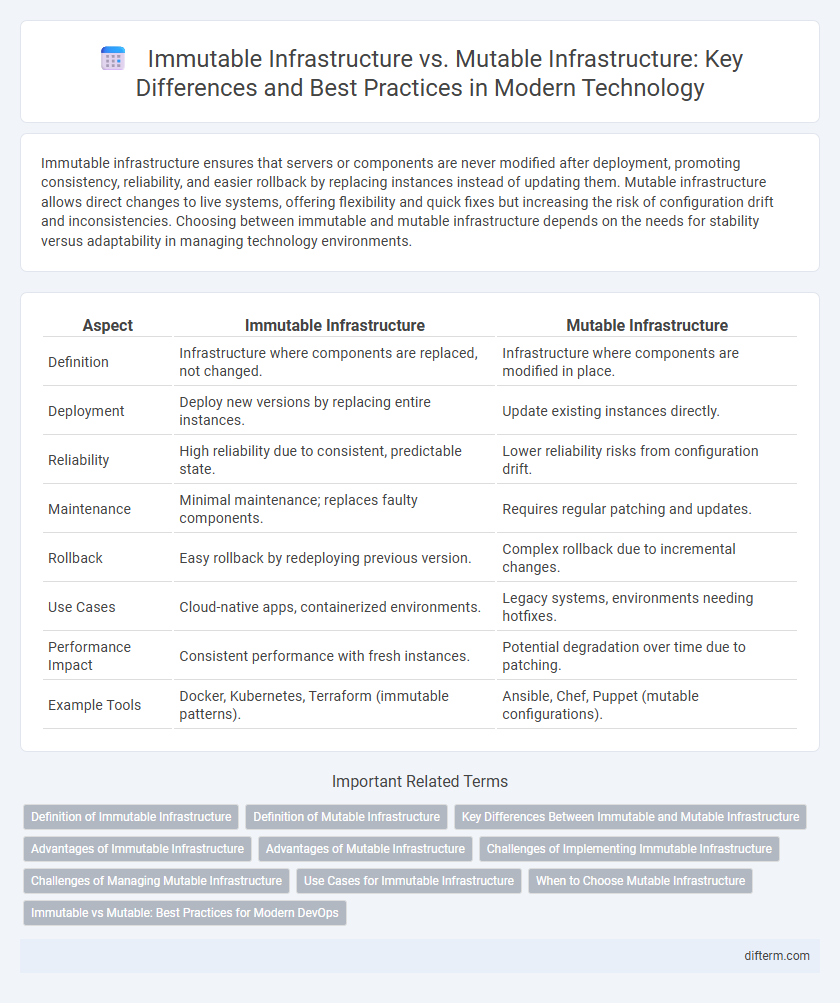Immutable infrastructure ensures that servers or components are never modified after deployment, promoting consistency, reliability, and easier rollback by replacing instances instead of updating them. Mutable infrastructure allows direct changes to live systems, offering flexibility and quick fixes but increasing the risk of configuration drift and inconsistencies. Choosing between immutable and mutable infrastructure depends on the needs for stability versus adaptability in managing technology environments.
Table of Comparison
| Aspect | Immutable Infrastructure | Mutable Infrastructure |
|---|---|---|
| Definition | Infrastructure where components are replaced, not changed. | Infrastructure where components are modified in place. |
| Deployment | Deploy new versions by replacing entire instances. | Update existing instances directly. |
| Reliability | High reliability due to consistent, predictable state. | Lower reliability risks from configuration drift. |
| Maintenance | Minimal maintenance; replaces faulty components. | Requires regular patching and updates. |
| Rollback | Easy rollback by redeploying previous version. | Complex rollback due to incremental changes. |
| Use Cases | Cloud-native apps, containerized environments. | Legacy systems, environments needing hotfixes. |
| Performance Impact | Consistent performance with fresh instances. | Potential degradation over time due to patching. |
| Example Tools | Docker, Kubernetes, Terraform (immutable patterns). | Ansible, Chef, Puppet (mutable configurations). |
Definition of Immutable Infrastructure
Immutable infrastructure is a design paradigm where servers or components are replaced entirely rather than being modified or updated in place, ensuring consistency and reducing configuration drift. This approach enhances reliability and simplifies rollback processes by deploying new instances with the required updates instead of altering existing ones. Key technologies supporting immutable infrastructure include containerization, infrastructure as code (IaC), and automated provisioning tools.
Definition of Mutable Infrastructure
Mutable infrastructure refers to IT environments where servers and resources can be modified or updated after deployment, allowing direct changes such as software patches, configuration updates, or system upgrades on live systems. This approach contrasts with immutable infrastructure, where components are replaced rather than altered. Mutable infrastructure provides flexibility but risks configuration drift and inconsistencies due to ongoing modifications.
Key Differences Between Immutable and Mutable Infrastructure
Immutable infrastructure ensures that once deployed, servers or components are never modified, promoting consistency and reliability through version-controlled, replaceable instances. Mutable infrastructure allows direct updates and changes to live systems, enabling flexibility but increasing risks related to configuration drift and inconsistencies. The key differences lie in deployment strategies, with immutable infrastructure emphasizing automated replacements for updates, while mutable relies on in-place modifications, impacting scalability, maintenance, and rollback capabilities.
Advantages of Immutable Infrastructure
Immutable infrastructure enhances system reliability by eliminating configuration drift and ensuring consistent environments across deployments. It simplifies rollback processes and reduces human error by replacing entire server instances instead of modifying them in place. This approach improves security through standardized, version-controlled infrastructure that is easier to audit and maintain.
Advantages of Mutable Infrastructure
Mutable infrastructure allows on-the-fly updates and modifications, enabling rapid troubleshooting and real-time configuration changes without full redeployment. This flexibility supports dynamic testing environments and quick adaptation to evolving requirements, reducing downtime. Teams benefit from simplified workflows and faster iteration cycles, boosting overall operational efficiency and responsiveness.
Challenges of Implementing Immutable Infrastructure
Implementing immutable infrastructure faces challenges such as the need for a robust automation pipeline to manage frequent redeployments, which can strain development and operations teams. Integration with existing mutable systems often requires significant changes in toolchains and workflows, adding complexity and potential downtime risks. Ensuring consistent security and compliance across immutable components demands enhanced monitoring and version control strategies to prevent configuration drift.
Challenges of Managing Mutable Infrastructure
Managing mutable infrastructure presents significant challenges due to configuration drift, where manual changes cause inconsistencies across environments, leading to unpredictable behavior and downtime. Security vulnerabilities often arise from untracked updates and patching delays, increasing the risk of breaches. Furthermore, scaling and disaster recovery become complex as mutable systems require extensive documentation and human intervention to restore desired states accurately.
Use Cases for Immutable Infrastructure
Immutable infrastructure is ideal for cloud-native applications requiring consistent and repeatable deployments, such as microservices architectures and continuous integration/continuous deployment (CI/CD) pipelines. It enables rapid scaling and disaster recovery by replacing entire server instances rather than applying patches, ensuring a clean and predictable environment. Use cases include containerized applications, serverless environments, and environments demanding high security and compliance where configuration drift must be avoided.
When to Choose Mutable Infrastructure
Mutable infrastructure is ideal when rapid experimentation and iterative updates are needed, allowing developers to modify live systems directly without full redeployment. It suits environments requiring frequent patching, debugging, or stateful applications where preserving runtime data is critical. Choosing mutable infrastructure supports flexibility in dynamic development cycles and legacy system maintenance.
Immutable vs Mutable: Best Practices for Modern DevOps
Immutable infrastructure ensures consistency and reliability by deploying new instances for every change, eliminating configuration drift and reducing deployment risks in DevOps workflows. Mutable infrastructure allows direct modifications to running systems, offering flexibility but increasing the chances of configuration inconsistencies and harder rollback processes. Best practices recommend favoring immutable infrastructure for scalable, automated CI/CD pipelines while using mutable approaches selectively for legacy systems or urgent hotfixes.
Immutable infrastructure vs Mutable infrastructure Infographic

 difterm.com
difterm.com